
On a few occasions I have written about courses that I've played on before and really liked, most notably, Maidstone. I haven’t played Sunningdale in years and recently played it again. I had forgotten just how much I like it. This time with digital camera in tow, I got some nice pictures and thought I would update the post.
Located right down the road from the Wentworth Estate in Ascot, Surrey, adjacent to land owned by the Crown Estate (The Queen) is Sunningdale, one of the world's great golf courses. Sunningdale Old (ranked #44 in the world) was designed by Willie Park Jr. in 1901 and was tinkered with over the years by H.S. Colt who served as the secretary at Sunningdale. Once you enter inside the electronic entrance gates, you are in an oasis. The clubhouse, locker room, pro shop and property have a good feel to them, and the course has an intangible quality that makes it special.
I have always liked clubs of the understated variety, those that just have a good vibe about them. Sunningdale is comfortable, welcoming, traditional and has a patina and character that you only get through graceful aging.
Heathland courses such as Sunningdale were developed primarily because of the underlying land's resemblance to seaside links courses. They take advantage of sandy soil, the absence of mud in the winter and good drainage. Most of the area around London has a clay base and thus is not ideally suited for golf. Sunningdale, in the Surray heathland, is one of the brilliant exceptions.
Golf is sometimes referred to metaphorically as a walk in the park. In the case of Sunningdale, it is literally true. The course is surrounded by deep woods and is idyllic and peaceful. Its scenic beauty stacks up against the world's best. It achieves a high ranking in the world without being located near the water and without having hosted any Open Championships. The combination of the natural terrain, sand, birch trees, heather, gorse, pines and water come together beautifully to create a unique environment. It feels like one big classic English garden. Sunningdale is the quintessential English golf club in many respects. Aside from the stately English clubhouse, there are walking paths around the course where people stroll about with their dogs in peaceful solitude, and like Britain in general, it's delightfully quirky.
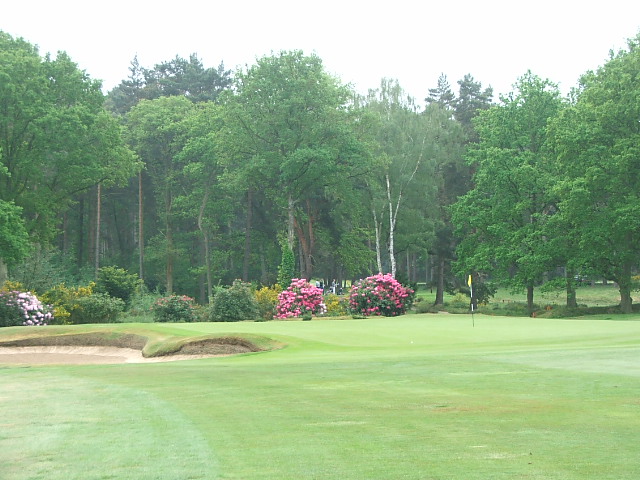
The first green in a park-like setting
I like a relatively easy starting hole, and the short par five first (492 yards) with O.B. down its right side, eases you into the round. Sunningdale reminds me a bit of Pine Valley. You can see the similarities between Pine Valley and Sunningdale throughout the round. This is not entirely surprising given Colt's influence on the design at Pine Valley.
The 3rd green could just as well be at Morfontaine
Aside from Pine Valley, Sunningdale also reminds me of Morfontaine because of its heavily wooded heathland setting in a forest. Sunningdale was built at a time when it was not in vogue to actively move terrain. Willie Park, Jr. is an important architect Thus, Sunningdale is a historic course, in addition to being so spectacularly beautiful. The Old course follows the natural contours of the land brilliantly. I like the use of cross-bunkers 60 to 80 yards from many greens, which creates doubt when hitting approach shots. Park's mixture of long holes, short holes, uphill and downhill is the ideal combination. The demanding par four (489 yard) second hole wakes you up after the easy first hole. It asks that you hit to the proper angle off the tee over heath. Mind the ditch down the left side of the hole if you want to score well. The blind second shot is to a well protected, canted green.
The sixth hole with its beautiful cross-bunkering
Sunningdale arguably has one of the top five routings of any golf course ever built (Pine Valley, Carnoustie, Sand Hills and Cypress Point in the mix). The shot variety, change in direction, change in elevation and mix of holes is top of the heap. Aside from the top shelf routing, the other defining features are forced carries over heather and scrub and the very well-placed cross-bunkering. You can see these to great affect in the picture of the 433 yard par four sixth hole, above.
The seventh is just a fantastic hole from tee to green and one of my favorites in the world. The tee shot is completely blind and plays to a hill that slopes sharply from right to left. The hole plays 406 yards and dog-legs to the right.
The seventh seen looking back from the fairway to the tee
Shots hit to the left will roll down the hill, potentially leaving you a shot blocked by trees. Even if you are not blocked by trees, the left side leaves a much more difficult angle to approach the uphill green from.
Approach to Sunningdale's 7th green
The elevated green is extremely well-protected. It is also large and slopes from back to front. The best tee shot is to the right side of the fairway, on the top of a little plateau that gives you a clean shot at the green.
The seventh green at Sunningdale looking back
The seventh is the middle of a fabulous three hole stretch that offers great shot variety and scenery. The 277 yard ninth is another very good example of a risk/reward hole with an extremely large green and well placed bunkers just short for those that try to go for it from the tee. The tee shot is essentially blind. Nine is an easy hole, which is a good thing, because the next hole is decidedly not.
Sunningdale's signature 10th hole
Sunningdale's 475 yard par four tenth hole is also a world-class hole. The hole plays from the highest point on the course down into a massive sweeping valley up to a well-protected elevated green. It's a real cracker and difficult.
The well-stocked halfway house off the tenth green offers traditional English fare including lovely egg mayonaise or bacon & chicken sandwiches. You wait at the halfway house for the group ahead to ring the bell on the eleventh green when they are done to indicate you can proceed.
I like short quirky par fours like the 322 yard eleventh, which makes for a nice breather between the two hardest holes on the course. This is classic Sunningdale. After beating you up, it hits you with a short par four to balance off being too harsh. The twelfth has a tee shot similar to the blind third hole at Royal Adelaide. I would imagine some people wouldn't like Sunningdale because it has some blind shots and several short holes. The genius in the routing is that hard holes are followed by those of relative ease. A long hole is usually followed by a short one, etc. Sunningdale does not have a weak set of holes anywhere on the course. What makes them all good is the risk/reward nature of them combined with their natural beauty.
Another nice feature of Sunningdale is that the walk from green to tee is always delightfully short, but never forced. Unlike Park’s design at Maidstone, there are no holes or shots across other holes.
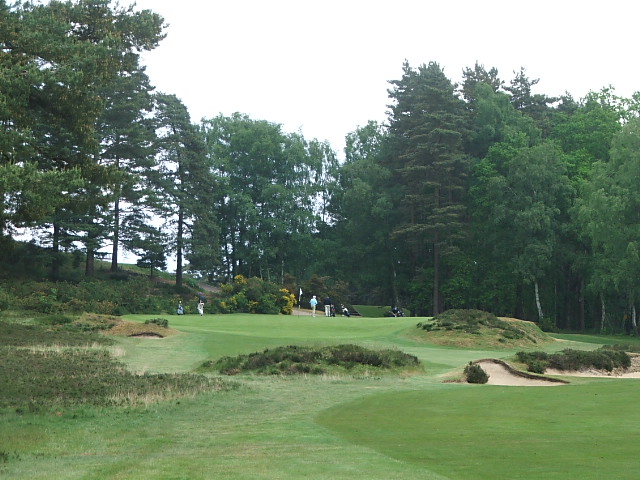
The approach to the twelfth green
Aside from a world-class golf course, Sunningdale also has a very strong Bobby Jones history. It was on Sunningdale Old during an Open Championship qualifier in 1926 that Jones shot what was described as a perfect round. The standard scratch score on the course at the time was 75. He shot a 66 with a 33 on the front and a 33 on the back. He had 33 full shots and 33 putts. The highest number written on his scorecard was a four. This feat is even more incredible if put into its proper context. He was using hickory shafted clubs and a golf ball that was nowhere near those of today's standards. On ten holes he hit his shot to the green with a two iron or a wood. The more I learn about Bobby Jones, the more I see why he is a golf legend.
Sunningdale's "Stockbroker's Tudor" clubhouse behind the 18th green
I’ve had some difficult rounds on my travels, but at Sunningdale everything finally clicked and I played to my true potential. About time. It was nice to finally have some payback for pounding all those balls on the range and suffering through so many poor shots. The round was made even more pleasant by having a caddie who has carried bags here for forty years.
As with the first time I played here, I had a very nice apres-round Guinness to celebrate. Sunningdale has a lot of members who work in the financial industry, aka "The City.” Where else can you overhear a conversation like this on the front porch after a round over drinks? "We spent the winter in St. Moritz; our next big adventure is to Antarctica. In between, we'll have a “short” two week trip to Kilimanjaro. And of course, we’re spending June and July in Cannes. It’s quite easy now to just have a Bloomberg installed in your holiday home so you can keep up with the markets and “pop in” to London for one or two nights if necessary to attend to business." They were not discussing this to boast. Quite the opposite, in typically English style they were being discrete and spoke in a near whisper. Although my rabbit ears are a big detriment when I’m trying to fall asleep, they come in handy for listening in on conversations. It gives you a good sense for the type of membership Sunningdale has. They're not living paycheck-to-paycheck (more accurately in Britain pay packet-to-pay packet) at this most aristocratic of clubs.
As I've said before, I have had few finer experiences than sitting in the Sunningdale clubhouse after the round of golf with a pint reflecting back on a brilliant day's golf. Sunningdale is in a small group of courses that combine the best of both worlds - a world-class golf course with a great, warm and inviting club. Others are Maidstone, Somerset Hills, Yeamans Hall, The Valley Club of Montecito, Morfontaine, Royal Liverpool and San Francisco Golf Club, to name the best of the bunch.
Bobby Jones sums up Sunningdale in one eloquent sentence that perfectly captures my sentiments: "I wish I could take this course home with me."
Fantastic!
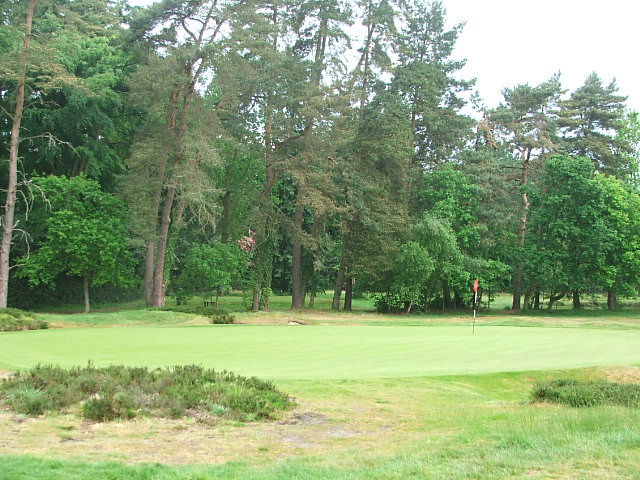

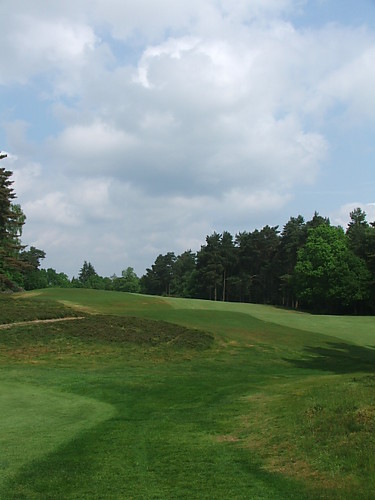
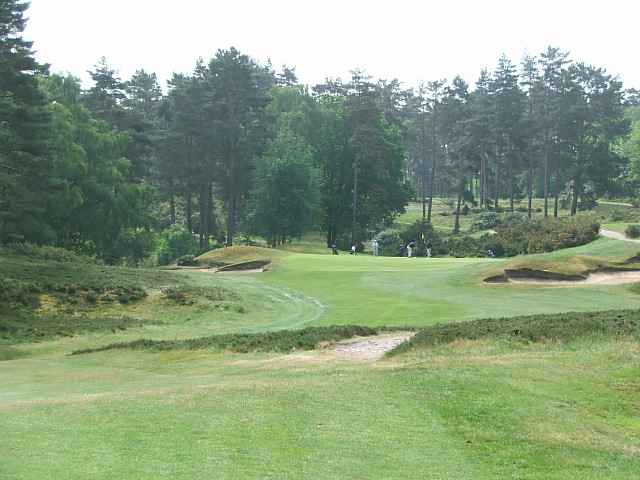

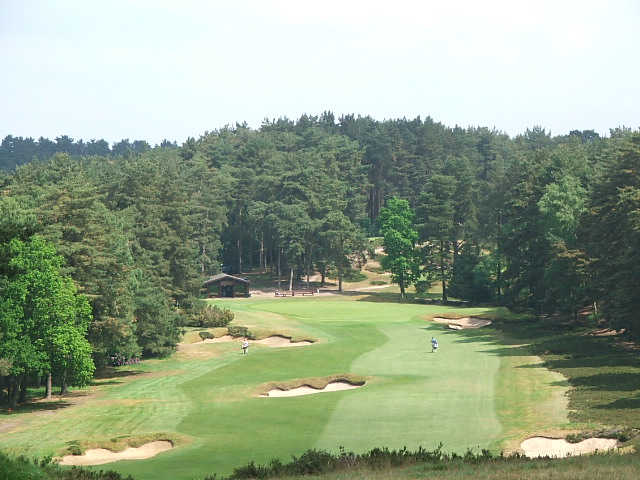
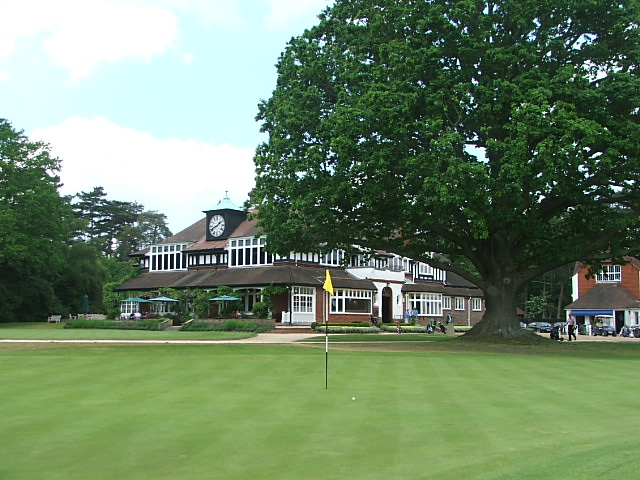




Tidak ada komentar:
Posting Komentar